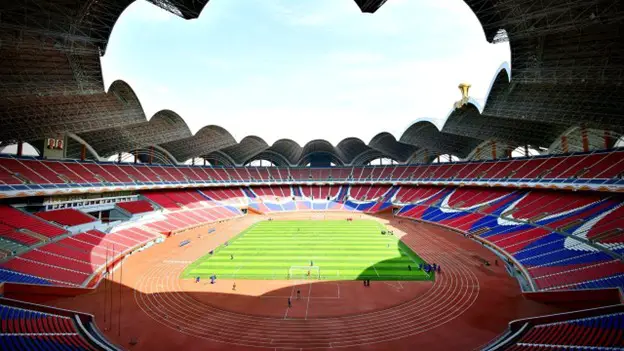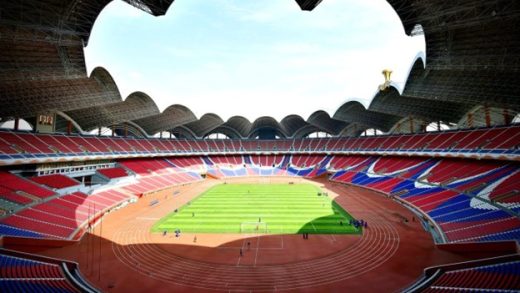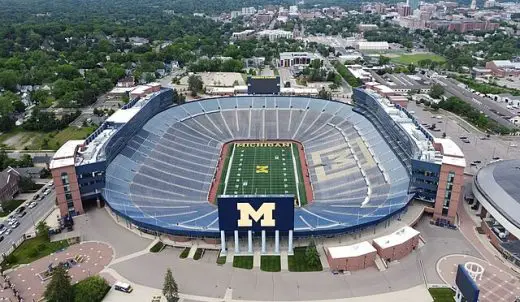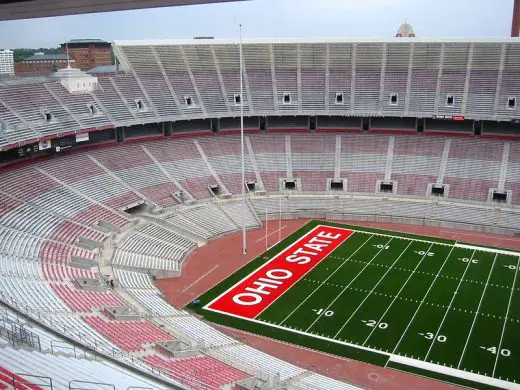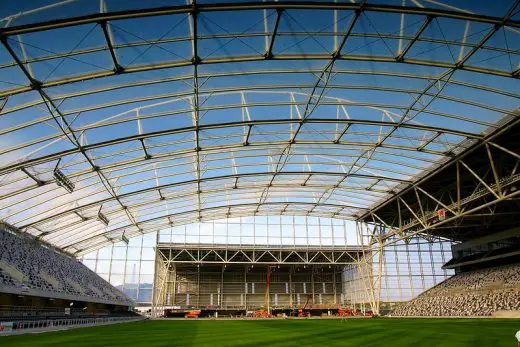Top-5 biggest football stadiums and their history, Sport building images, Sports arena architecture structures
Giants of the Globe: Exploring the World’s Top 7 Largest Stadiums
May 17, 2024
Stadiums are not merely venues for sporting and entertainment events; they are grand stages that showcase human ambition and architectural prowess. The world’s largest stadiums, often celebrated as engineering landmarks, accommodate hundreds of thousands of spectators and resonate with the echoes of significant historical events. Whether it’s the Maracanã in Rio de Janeiro, which hosted two FIFA World Cup Finals, or the Rungrado 1st of May Stadium in Pyongyang, North Korea, the largest stadium by capacity, these colossal structures are more than their physical dimensions. They symbolize cultural identity and unity, serving as epicenters for major global sports events, concerts, and political rallies. This discussion delves into the magnificence of these architectural behemoths, exploring their impact beyond the roar of the crowds they house.
Top 7 Largest Stadiums in the World
The world’s largest stadiums stand as monumental achievements in architecture and engineering, drawing massive crowds for sports and entertainment events. These venues, including the expansive Rungrado 1st of May Stadium in North Korea and the iconic Michigan Stadium in the USA, are central to their communities, much like the best NZ online casinos are to their virtual players. Join us as we explore the top seven largest stadiums around the globe, each with its own story of grandeur and communal spirit.
| Stadium | Country | City | Capacity | Build Year |
| Rungrado 1st of May Stadium | North Korea | Pyongyang | 114,000 | 1989 |
| Michigan Stadium | USA | Ann Arbor, MI | 107,601 | 1927 |
| Beaver Stadium | USA | University Park, PA | 106,572 | 1960 |
| Ohio Stadium | USA | Columbus, OH | 102,780 | 1922 |
| Kyle Field | USA | College Station, TX | 102,733 | 1927 |
| Tiger Stadium | USA | Baton Rouge, LA | 102,321 | 1924 |
| Darrell K Royal-Texas Memorial Stadium | USA | Austin, TX | 100,119 | 1924 |
1. Rungrado 1st of May Stadium – Pyongyang, North Korea
- Capacity: 114,000
- Opened: May 1, 1989
- Main Uses: Football, athletics, and mass games
- Architectural Feature: The stadium is noted for its 16 arches that resemble a magnolia blossom, an important national symbol in North Korea.
- Historical Significance: This stadium holds the record for the largest attendance at any sporting event in North Korea, accommodating numerous mass games that showcase gymnastics and dance as a form of political expression and mass mobilization.
- Interesting Fact: The Rungrado 1st of May Stadium hosts the Arirang Mass Games, which are recognized by the Guinness Book of World Records for having the largest gymnastic display with over 100,000 participants.
2. Michigan Stadium – Ann Arbor, Michigan, USA
- Capacity: 107,601
- Opened: October 1, 1927
- Main Uses: College football
- Architectural Feature: Originally built with a capacity of 72,000, the stadium has undergone numerous expansions to reach its current size, maintaining its classic bowl shape throughout all renovations.
- Historical Significance: Michigan Stadium has been the site of presidential speeches, major league soccer games, and even NHL events, marking it as a versatile and culturally significant venue.
- Interesting Fact: In 2013, Michigan Stadium set the NCAA single-game attendance record when it hosted a football game against Notre Dame, drawing an unprecedented crowd of 115,109 spectators.
3. Beaver Stadium – University Park, Pennsylvania, USA
- Capacity: 106,572
- Opened: September 17, 1960
- Main Uses: College football
- Architectural Feature: Beaver Stadium is known for its expansions that have incrementally added seats over the decades, evolving from a modest facility into one of the largest in the world.
- Historical Significance: It serves as the home of Penn State Nittany Lions football team and is famed for its “White Outs,” where fans dress entirely in white to create a daunting atmosphere for visiting teams.
- Interesting Fact: Beaver Stadium is renowned for its electric college game-day atmosphere, often cited as one of the best in America due to its large, passionate crowds.
4. Ohio Stadium – Columbus, Ohio, USA
- Capacity: 102,780
- Opened: October 7, 1922
- Main Uses: College football
- Architectural Feature: Known as “The Horseshoe” or simply “The Shoe” because of its distinctive shape, Ohio Stadium combines traditional aesthetics with modern facilities.
- Historical Significance: This stadium is on the National Register of Historic Places and has hosted diverse events including summer concerts, and university spring commencement ceremonies.
- Interesting Fact: The record attendance was set in 2016 during a game against the University of Michigan, with over 110,000 fans in attendance, underscoring its massive draw and importance in college sports.
5. Kyle Field – College Station, Texas, USA
- Capacity: 102,733
- Opened: September 24, 1927
- Main Uses: College football
- Architectural Feature: Kyle Field underwent a major renovation in 2015, which included upgrading facilities and expanding seating capacity, making it one of the largest in the SEC.
- Historical Significance: It is the home of the Texas A&M Aggie football team and is known for some of the loudest and most intense college football games in the country.
- Interesting Fact: Kyle Field holds the record for the highest decibel level ever recorded at a college football game, contributing to its reputation as one of the most intimidating places to play.
6. Tiger Stadium – Baton Rouge, Louisiana, USA
- Capacity: 102,321
- Opened: November 25, 1924
- Main Uses: College football
- Architectural Feature: Often referred to as “Death Valley,” Tiger Stadium is famed for its night games where the stadium’s atmosphere is electrified by passionate fans and vibrant traditions.
- Historical Significance: It has hosted numerous memorable games, including the “Earthquake Game” in 1988, which was so loud that it reportedly registered as an earthquake by a seismograph located in the stadium.
- Interesting Fact: Tiger Stadium is not only known for its incredible game-day atmosphere but also for the tradition of fans staying and celebrating long after games conclude, enhancing its community and cultural significance.
7. Darrell K Royal-Texas Memorial Stadium – Austin, Texas, USA
- Capacity: 100,119
- Opened: November 8, 1924
- Main Uses: College football
- Architectural Feature: The stadium boasts a mix of historic and modern architecture, with recent renovations focusing on luxury seating and modern amenities to enhance fan experience.
- Historical Significance: Home to the University of Texas Longhorns, it has been a cornerstone of college football, with a rich history of hosting major football games and significant cultural events.
- Interesting Fact: It includes the “Godzillatron,” one of the largest high-definition video screens in collegiate sports, enhancing the visual experience for fans and making it a technologically advanced stadium.
Biggest Stadiums in New Zealand
New Zealand may be more widely recognized for its breathtaking landscapes and vibrant culture, but it also boasts some of the most impressive sports stadiums in the Southern Hemisphere. These facilities are not merely architectural feats; they serve as cultural hubs that accommodate a multitude of sporting and large-scale events, attracting audiences from across the nation and around the globe.
From the historic Eden Park in Auckland to the technologically advanced Forsyth Barr Stadium in Dunedin, New Zealand’s stadiums are emblematic of the country’s profound passion for sports and communal activities. In this section, we delve into the largest and most iconic stadiums across New Zealand, highlighting their capacities, state-of-the-art facilities, and their pivotal roles in enhancing the Kiwi sports experience.
1. Eden Park
- Location: Auckland, New Zealand
- Capacity: Approximately 50,000
- Opened: 1900
- Main Uses: Rugby, cricket
Eden Park is New Zealand’s largest sports stadium. Primarily used for rugby union in winter and cricket in summer, it is a hub of sporting activity year-round. The stadium has hosted a number of significant events, including the 2011 Rugby World Cup Final and numerous cricket matches during the ICC Cricket World Cup. Its historical significance in New Zealand sports culture is profound, having been the stage for various historic sporting moments. Architecturally, it has undergone several renovations to modernize its facilities and expand seating capacity to meet international standards.
2. Forsyth Barr Stadium
- Location: Dunedin, New Zealand
- Capacity: Approximately 30,748
- Opened: 2011
- Main Uses: Rugby, football
Forsyth Barr Stadium, also known as the Glasshouse due to its transparent roof, is one of the most modern venues in the country. It is the world’s first fully enclosed stadium to have a natural grass pitch, made possible by its transparent roof which allows sunlight to reach the grass. The stadium serves as a home ground for the Highlanders in Super Rugby and the Otago Rugby Football Union. Its design is praised for creating an intimate atmosphere, enhancing the spectator experience during events.
3. Westpac Stadium
- Location: Wellington, New Zealand
- Capacity: 34,500
- Opened: 2000
- Main Uses: Rugby, football, cricket
Westpac Stadium, commonly referred to as the Cake Tin, is Wellington’s major sporting venue. It hosts a variety of events, including rugby union matches, football games, and significant cricket matches. The stadium’s design features a circular, silver-colored exterior and has been a central venue for events like the Wellington Sevens part of the World Rugby Sevens Series. It also provides panoramic views of the Wellington waterfront, adding to its appeal as a key destination for sports and entertainment.
These stadiums not only serve as sports venues but also as cultural landmarks that host a range of concerts and other community events, reflecting the vibrancy of New Zealand’s sporting and public event landscape.
Technological and Architectural Innovations in Stadium Design
Modern stadiums are not just built to hold large numbers of spectators; they are marvels of engineering designed to enhance the fan experience and reduce environmental impact. Technological advancements and innovative architectural designs play crucial roles in achieving these goals.
Eco-Friendly Design
Many of today’s stadiums incorporate sustainable practices, from using recycled materials in construction to installing solar panels and rainwater harvesting systems. For example, the Mercedes-Benz Stadium in Atlanta is LEED Platinum certified, featuring a solar panel array capable of powering over 160 homes annually.
Fan Experience and Safety
Technological innovations have greatly enhanced the spectator experience. High-definition giant screens, advanced sound systems, and widespread Wi-Fi access ensure fans don’t miss a moment of the action. Additionally, modern security systems, including advanced surveillance and crowd management technologies, have made these large venues safer than ever.
Multipurpose Facilities
The architectural flexibility of modern stadiums allows them to host a variety of events. Retractable roofs, adjustable seating configurations, and state-of-the-art lighting systems enable venues to switch between hosting sports events, concerts, and other major gatherings with ease.
Accessibility
Innovations in design also focus on inclusivity. Features like barrier-free access routes, adequate seating for people with disabilities, and sensory rooms make stadiums accessible to all fans, ensuring everyone can enjoy the events hosted.
These innovations not only improve the usability and safety of stadiums but also ensure they remain relevant and economically viable in the competitive landscape of global venues.
Challenges Associated with Large Stadiums
While large stadiums are impressive, they come with their own set of challenges, including maintenance, operational costs, and environmental concerns.
Maintenance and Operational Costs
The larger the stadium, the higher the maintenance costs. These venues require significant resources for upkeep, from structural repairs to daily cleaning and security. Moreover, the cost of staffing necessary for operations, security, and customer service can be substantial.
Environmental Impact
Large stadiums consume massive amounts of energy, from lighting to heating and cooling vast spaces, contributing to significant carbon footprints. Managing waste and water usage also presents substantial environmental challenges, especially in areas where resources are scarce.
Logistical Challenges
Coordinating events in such large venues involves complex logistical planning, from traffic management and parking to crowd control and emergency services coordination. Ensuring a smooth operation during high-attendance events requires meticulous planning and coordination.
These challenges necessitate innovative solutions and ongoing investment to ensure that the benefits of these large stadiums continue to outweigh the costs.
Biggest Stadiums in the World Conclusion
The world’s largest stadiums are more than just sports venues; they are symbols of human ingenuity and cultural significance. As we look to the future, the trends in stadium design and construction are likely to emphasize sustainability and technology even more.
These efforts will aim to reduce environmental impacts and enhance the fan experience, ensuring that these monumental structures can continue to inspire awe and gather masses for generations to come.
Comments on this guide to top-5 biggest football stadiums and their history article are welcome.
Football Stadiums
Football Stadium Buildings – Selection:
New Chelsea Football Stadium
Architect: Herzog & de Meuron

image from architect
Emirates Stadium : Arsenal FC ground, London
Design: HOK Sport Architecture
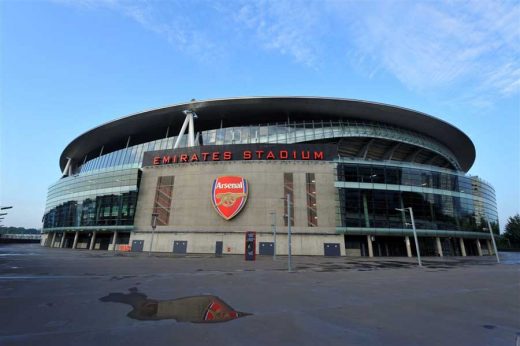
photo © Nick Weall
Tottenham Hotspur Stadium:

photo © Greshoff
New San Siro
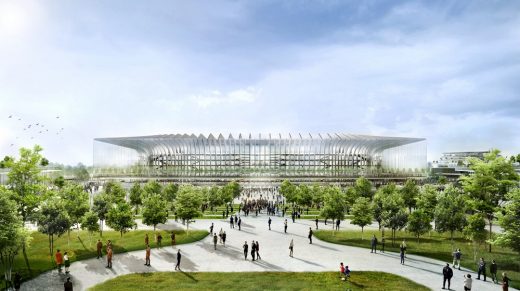
image courtesy of architects
Wembley Stadium, London
Design: Foster + Partners / HOK Sport

photo © Nick Weall
West Ham United Football Stadium
Comments / photos for the Giants of the Globe – Top-5 biggest football stadiums and their history page welcome.

